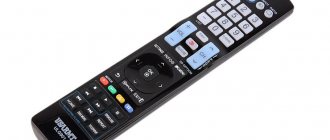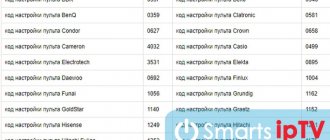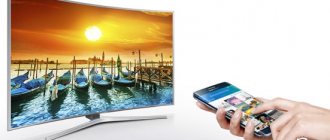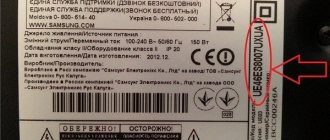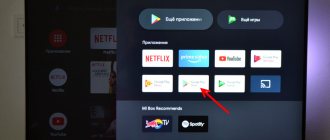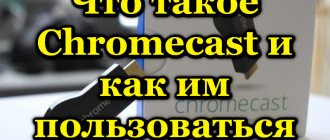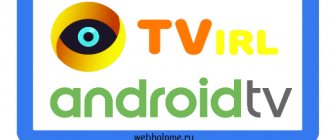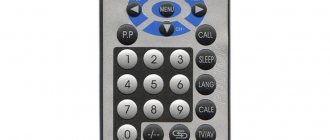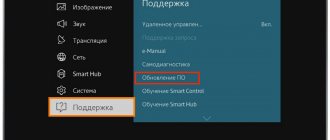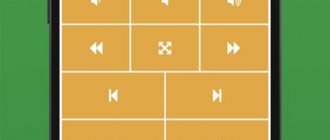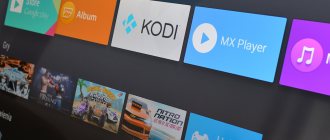Can I control my TV from my Android smartphone? Almost everyone wants an answer to this question. After all, this is, firstly, very technologically advanced and modern, and, secondly, the remote control can fall into nowhere, and switching channels or, especially, launching YouTube from the buttons on the TV body is still a pleasure. At one time, I also faced this question, but I solved it using a simple Android application. I'll tell you what kind of application this is, how it works and how to replace it in case of incompatibility.
I've been controlling my TV using my smartphone for a long time now.
Why does voicemail turn on on Android and how to fix it
The app in question is called SmartThings from Samsung. It is available on Google Play absolutely free, so anyone can download it. Another thing is that its compatibility specifically with your TV is not guaranteed. In order to connect a smartphone with the application and a TV, it is important that the latter supports the Smart TV function.
What is the difference between Smart TV, Android TV and Google TV?
Smart TV is a category of televisions that combine TVs with Internet connectivity, meaning they can connect to the network and access online applications and services.
Google or Android TV is any television that uses the Android™ operating system (OS) from Google Inc. TVs with Android TV have been included in Sony's TV lineup since 2015, and TVs with Google TV since 2021. Smart TVs come with a variety of pre-installed apps, and Android systems have access to apps in the Google Play Store, a portal from which users can download additional apps designed to run on the Android OS. If you're not sure what kind of TV you have, there are four ways to check:
- TV main menu screen
- Product Description Page
- TV remote control
- Characteristics
Disadvantages of technology
Despite the large number of advantages, this technology has a number of disadvantages. The disadvantages of using smart TV are:
- inability to play video of non-traditional standards. This includes, for example, .mkv, the “sailor suit” container. When trying to play such files, sound problems may occur;
- infrequent updates of the built-in application store, especially games. It's also not very convenient to use the remote as a joystick for gameplay;
- some models of smart TVs have limitations in watching movies or fully surfing the Internet;
- high price. You won’t be able to buy a TV with smart TV inexpensively, since you have to pay extra for the service. You should be prepared for this when you need to choose a new TV receiver for your home.
TV main menu screen
Press the HOME
on the remote control to access the main menu screen.
Google TV
On TVs with Google TV, the main
The menus appear as shown below: (Please note that the
Home
Menu screen on your Google TV varies depending on whether you are signed in to a Google Account.)
- If you're signed in to Google on your TV:
In the top left corner is
Google TV
. - There is a Google account icon in the top right corner, and when you click on it, the control panel appears.
- At the bottom of the screen is information about Google TV
.
Android TV
On Android TVs, the home
The menu is displayed as shown below.
The main
screen on your Android TV is similar to the
main
menu screen, but there is no Google Account icon in the top right corner of the screen.
Instead, a clock
or an icon (
Settings
) is displayed there. The icons in the upper right corner of the screen vary depending on the model or settings.
Other type of Smart TV
Below are examples of home
menu of other types of TVs.
These TVs do not use Android OS. The main
screens may vary depending on the model and available applications.
Operating systems used in smart TVs
To confidently navigate the question of how to connect a smart TV and use the system in the future, you should understand the variety of operating systems. Almost every major smart TV manufacturer installs its own firmware. Initially, you should connect the TV receiver directly to the Internet. This can be done in three ways:
- Via a network cable connected to the LAN port on the rear panel of the receiver.
- Via a Wi-Fi receiver built directly into the TV.
- By connecting the router to the USB port of the TV and synchronizing it with your home wireless Internet transmitter.
The list of the main operating systems used in Smart TV is as follows:
- Android . This system is used primarily by manufacturers such as Sony, Sharp, TLC. If we rank the operating systems used on TVs, then this one can be considered the simplest. In appearance and functionality, Android installed on a TV is no different from a similar system used in a modern smartphone.
- Tizen . This “axis” is a proprietary development of Samsung and is used only in models produced by this major. Constant system updates make it increasingly easier to use smart TV. The interface is simplified, the navigation system becomes intuitive, and it is possible to create a “smart home” system based on TV.
- webOS . Operating system used on LG TVs. It first appeared in 2014 and has since received its third update. One of the features of this OS is the presence of interesting functions, including Magic Zoom, through which you can enlarge any area of the screen, or Magic Mobile Connection, which allows you to combine all devices into a single complex.
- FirefoxOS . _ A system that was developed by Mozilla specifically for smart TVs from Panasonic.
- Roku TV . Not a very common system that can be found in models from Sharp, TLC and Hisense. A special feature of this OS is the presence of a built-in player based on Chromecast and Apple TV, which makes it possible to broadcast movies or music on the TV screen. The advantage of this development is the ability to use software for both Android and iOS.
An example of the webOS operating system for LG TVs
Product Description Page
This support website has a product page for each unique model where you can find manuals, downloads, and answers to questions. To access this page, enter the model name in the search bar. At the top of this page is a product description indicating the type of TV - Google TV, Android TV or Smart TV.
Here are three examples:
Google TV product page
Android TV product page
Product page of a different type
TV technologies that are becoming a thing of the past
Sometimes what was recently perceived as a progressive innovation and was actively promoted to the masses is suddenly relegated to the background. And then it completely disappears and is forgotten. And all because users didn’t like it.
Starting in 2021, television equipment manufacturers plan to abandon the production of smart TVs with 3D technologies. The reason is that the demand for such TVs turned out to be much less than expected. Firstly, because there is nothing to watch - digital television providers have not yet started creating 3D channels, and the existing content in this format is “the cat crying.” Secondly, the culture of watching TV through 3D glasses, which, by the way, are often of poor quality, has somehow not taken root at home.
The second technology that will soon be consigned to the dustbin of history is curved TV screens. The reason for refusing them also lies on the surface - they don’t buy. Well, not everyone, more precisely, almost no one likes to look at a distorted image if they were unable to take a place strictly opposite the central part of the TV. The latest manufacturer that is currently supplying curved panels to the market is Samsung. But he, as experts expect, will most likely abandon them in the coming years.
Enjoy watching your smart TV!
TV remote control
As a rule, if the included remote control has a Microphone
(or
Microphone
) is a TV with Google or Android TV.
Examples:
However, depending on the region and model, in some rare cases the Microphone
(or
Microphone
) may not even appear on a TV with Google or Android TV. In this case, the best indicator would be the main screen or technical specifications.
xxC series TVs
The Microphone
button is located on the touchpad remote control.
Network connection
The first and mandatory condition for high-quality work and use of all the capabilities of smart technology is an Internet connection to the television device.
Let's move on to the smart TV settings. There are two connection options:
- using a cable;
- via wi-fi.
The first method is the most preferable, since it will not be affected by various interferences, as is the case with a public network.
The cable wire is connected to the TV to the corresponding socket on the rear panel. The name of the connection point is LAN.
It is also worth considering the fact that to connect several devices to the modem at once, it is necessary to branch the wire.
A switch or hub is used for this. It is a wire that has only one branch at one end and several at the other.
One of the wires connects directly to the TV, and the others to the necessary additional mobile or stationary devices.
The second method does not require any additional wired connections. It is enough to correctly configure the available network.
Characteristics
If on the technical specifications page in the Software
—
The operating system
Android
OS , this is a TV with Android TV. You can check this information in the specifications tab located at the top left of your TV's product page.
For more information on how to find specifications, see Where can I find my TV specifications?
.
Key abbreviations
You can find this out in the instructions, but if you don’t have one, go online, which will be faster.
- DVB-T2 indicates that “digital” is supported;
- DVB-S, DVB-S2, DVB-S2X indicate reception of signals from a satellite;
- DVB-T, DVB-T2 – terrestrial;
- DVB-C, DVB-C2 – cable;
- DVB-T is an outdated model.
Below is a list of the most popular TV brands that support digital (you should pay attention to models after 2015):
- Samsung;
- Philips;
- Sony;
- LG;
- Panasonic;
- Toshiba.
Digital television is a modern take on entertaining and educational television programs. However, there is a more innovative technology - Smart TV.
Let's go deeper into details
Defective pixels
It seems that it’s not difficult to check the TV - turn it on and watch. But it’s not that simple—some display defects will only appear under certain conditions. Moreover, it may turn out that, by the manufacturer’s standards, they are not considered defects. The most obvious example of such reinsurance against the return or exchange of goods is the notorious dead pixels. A certain number of them is allowed by various standards, so if you discover this defect already at home, it will be extremely difficult to return the TV back. Therefore, it is better to check before purchasing.
It is quite easy to identify a completely non-working pixel, but a partially defective one is much more difficult. Each pixel is formed from three subpixels (red, green, blue). If one of them stops working correctly, then the dot on the screen will glow in the wrong color. Moreover, in order to catch the “saboteur”, sometimes you have to tinker - try to see the unfortunate point, for example, on the 50-inch LG 50UK6510PLB screen! Fortunately, you don’t have to arm yourself with a magnifying glass: it’s enough to prepare a flash drive with test pictures in advance that will identify the pest in any color range. Rarely, but still there are pixels that work incorrectly only periodically (when a neighboring point lights up in a certain shade). You can catch them using patterned pictures: with stripes, a grid, evenly alternating figures. Incorrectly functioning elements will stand out in the general row. To test a 4K display, this selection of images will be useful.
Illumination uniformity assessment
A full-screen black fill will allow you to evaluate the uniformity of the backlight. It is necessary to pay attention to the presence of “exposed” areas in different parts of the display. On LCD TVs, some differences are allowed, but if white spots are clearly visible on the black screen, this is a reason to look for a better copy or another model. As with dead pixels, most manufacturers do not consider this a defect, so it will be almost impossible to exchange a TV based on uneven backlighting.
Detection of colored "spots"
The white fill is no less important. Here you need to evaluate the presence of colored “spots” on the screen - most often they look like pinkish or greenish areas on a flat white color (the so-called tint). This “coloring” that appears in the matrix will remain on top of the main image, so devices with such a defect should be avoided. As in previous cases, many manufacturers will not consider the presence of “stains” a sufficient reason to exchange or repair the TV. At the same time, it wouldn’t hurt to check for banding, which appears in the form of stripes of a different shade. When watching regular TV shows, it will be noticeable in uniform areas when moving the camera. To identify this flaw, you need to send a uniform field of any color (gray, green, purple) to the screen from the same flash drive.
Technically, tint, highlights and banding are not defective or broken. It is almost impossible to find an LED TV without them. But the intensity of the interference varies; you should choose a device with minimally pronounced image defects.
"Pencil" test
Despite the assurances of marketers who depict cosmic refresh rate figures in the technical specifications, finding an “honest” 100 Hz TV today is still not easy. If before purchasing it was not possible to accurately determine the model of the matrix and find out its real capabilities, the popularly known “pencil” test will come to the rescue. To carry it out, you will need to present a very light picture, preferably white, to the display. Then take a pencil or any long and thin object and wave it in a semicircle 10-15 centimeters from the screen. If the individual contours of the pencil are not visible, there is no flicker. If several “pencils” are visible, the manufacturer has clearly added a zero to the real scan frequency, and the flickering of this instance will tire the eyes during prolonged viewing. You can verify the effectiveness of such a test using the example of the 100 Hz Samsung UE40MU6103UXRU display, placing it next to any 50 Hz model.
Sound check
You shouldn't have high hopes for ten-watt acoustics squeezed into the thin body of a modern TV. Of course, the bass reflex speakers Sony Bravia KDL40WD653BR sound quite decent for their size, but they cannot promise home theater level. Therefore, it is enough to simply check the sound for rattling using high-quality samples. At the same time, it makes sense to test the smoothness of volume control from the remote control along with the instant mute function.
Checking the connectors
It is very problematic to check the antenna input in a store, but if at least indoor antennas are on sale in the next department, you should not neglect this opportunity. Of course, the chance of running into a non-working TV tuner is small, but you can take your TV home with peace of mind.
USB ports are simply tested with the same flash drive with pictures to identify dead pixels. If the TV has two or more connectors (such as the LG 43UJ630V), nothing prevents you from checking them all one by one. If you plan to use Smart TV with a keyboard and mouse, it is better to take them with you. It may turn out that even with known-to-be-good USB connectors, the existing set will be incompatible with the TV. Here you will have to either come to terms with it or find a suitable replacement without leaving the cash register.
HDMI connectors are easy to test: most stores have demo stands with a bunch of cables that display the image on the display case. We just insert the cable into each of the ports one by one, nothing complicated. At the same time, it will become clear how conveniently they are located - this is important when planning connections for home devices.
The headphone jack can be checked even using a smartphone headset - its capabilities are quite enough to get a general idea of the performance of the 3.5 mm jack. Well, if you don’t want to bother with a wire, then take your wireless headphones and test the Bluetooth connection, since modern TVs are equipped with such an interface. And unfolding the 49-inch Samsung UE49MU7000UXRU screen hanging on the wall every time you want to watch a movie with headphones is a dubious pleasure.
Network check
An important point when buying a TV with Wi-Fi. Wireless Internet access is now available in almost any shopping center or even a separate store. The minimum program is to launch a search for networks and compare the number of those found with those “caught” on a smartphone. Ideally, connect to the store’s network and access the Internet. At worst, you can distribute Wi-Fi from your device. At the same time, you will have the opportunity to evaluate Smart TV. And in models such as the Philips 43PFS5302/12, full-fledged Android is installed: you can even view your email without leaving the display case.
conclusions
The main thing is to behave confidently in the store and understand that half an hour spent checking will save you a lot of nerves and time in the future. With this approach, you will definitely be able to make a successful purchase: there will be no dead pixels, screen glare or other troubles. And to avoid any problems with the ability to check, contact Citylink - for a symbolic amount, the store’s specialists will not only check your device, but will also give you time to get to know it yourself. And if necessary, they will also help with the setup.
